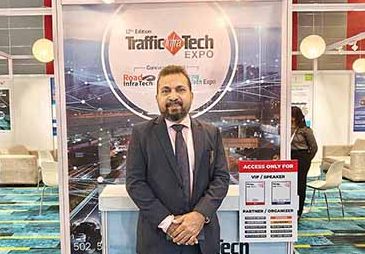Automotive systems major Continental has been aggressive in Asia with special focus
on China and India. The company’s Indian arm is gearing up to support the OEMs
emerging requirements by developing and adapting technologies to local needs.
Claude dGama Rose, Managing Director of Continental Automotive Components
India, spoke to T Murrali recently on the company’s plans. Edited excerpts:
 Q: Asia was to play a vital role for Continental according to its intent three years ago but sales in India has miserably been trailing – is there a change in strategy?
Q: Asia was to play a vital role for Continental according to its intent three years ago but sales in India has miserably been trailing – is there a change in strategy?
CR: Growth in Asia is an important aspect of Continental’s strategic target, the key countries being China, Japan, Korea, India and the ASEAN/SE Pacific region. Continental will continue to make significant investments in these developing markets, where our focus will be on safety, environmental-friendly technology, fuel efficiency and information solutions within vehicles. Our goal will be to promote localisation and customised products for the market at affordable prices. Overall our sales in Asia had grown to about six billion Euro in 2013 with China being the major driver of growth. China had recorded Euro three billion revenue in the previous year. In India, new car sales continued to decline during whole of last year and component companies have felt the impact of the reduced volumes. However, the underlying premise for long term growth – demographics, growth of rural economy – remains intact. The participants still believe in the market and new launches appear to be the tactic most likely to succeed in this market. We continue to be awarded new programmes which will generate future revenues.
Q: Can you update on the performance of India operations last year?
CR: Calendar 2013 was a difficult year for automotive companies across the board. In India, Continental too felt the effects of the market slowdown. The slowdown is clearly more prolonged than was expected and, as of now, no sustained pickup is discernible. OEMs and components suppliers alike look to new launches to boost industry volumes. In times like these, like many other organisations, we are focusing on preparing ourselves for the future. We are paying meticulous attention to material planning and trying to achieve a better balance between production and inventory. A few of the HR related measures we have taken include shift optimisation, cross-skilling of our employees and helping them to build their overall competence.
Q: Volumes are shifting from small cars to high segment cars. . .to what extent has this trend influenced Continental?
CR: Continental is well prepared to cater to the needs of all segments of vehicles. Current and future requirements in information management can only be met through networked thinking and development combined with a high level of integration. We offer a comprehensive product portfolio in the field of information management and, in turn, HMIs (Human- Machine Interfaces). Whether intelligent tyres, anticipatory transmission control systems, smart gas pedals or digital car keys on your cell phone, Continental is collaborating intensively with automobile manufacturers worldwide to develop products and systems that, with the help of state-of-the-art information processing, will offer solutions for future mobility concepts designed to increase efficiency, road safety and in-car comfort. We are focusing on integration: an optimised operating concept must allow drivers to safely use their familiar range of cell phone functions – whether simply to make a phone call or to access the internet – even when they are in the car. Particularly in the market for more affordable vehicles, like India, we are focusing on increased integration of cell phones in cars, thereby helping to keep investment costs for the driver to a minimum.
Q: Has content per vehicle grown for Continental in India?
CR: Despite the slowdown in the Indian automotive market, the volume of vehicle electronics on Indian vehicles, be it passenger cars or commercial vehicles, is on the rise. This uptake of electronics is driven by needs like safety, comfort and connectivity and networking. As rural infrastructure and the country’s road system continue to improve, the market will further grow and mature. India is an emerging market for us and we have strategic relationships with our key customers here. When demand grows, we will be the preferred supplier for our customers.
Q: The growth trajectory in the emerging markets made your headquarters (in 2010-11) weave its strategy accordingly – how has this intent evolved?
CR: In Asia, passenger car production in China and the ASEAN states grew strongly last year, more than offsetting declining production volumes in markets like India. Overall, passenger car production in Asia rose by around four percent year-on-year in the first nine months of 2013 according to preliminary data. Continental has invested significantly in Asia and continues to do so. Today Continental has 19 manufacturing locations 10 R&D centres, 10 joint ventures and 26 sales offices in China with over 17,000 employees. We have seven manufacturing locations in India, with all the divisions, both automotive as well as rubber of Continental represented in the country. Also we have a very broad product portfolio, which we continue to improve and extend. With this broad portfolio we want to serve global customers as well as Indian customers. We have a strong presence in other Asian countries including Singapore, Korea, Japan, Malaysia and in the ASEAN.
 Q: India is transforming and the penetration of safety features is in a very nascent stage; besides, this is a price sensitive market; in this scenario how are you able to drive your intent in the Indian OEMs?
Q: India is transforming and the penetration of safety features is in a very nascent stage; besides, this is a price sensitive market; in this scenario how are you able to drive your intent in the Indian OEMs?
CR: The number of fatalities on Indian roads is constantly increasing, with no turnaround on the horizon. Our motivation is our vision of driving with zero accidents (Vision Zero). We see three decisive steps to realis:e this: zero fatalities (no more fatal accidents), zero injuries (no more injuries) and zero accidents (protection of property). Therefore, Continental regards ‘Safety for All’ as a vital and decisive step. Continental offers safety technologies for installation in all vehicle categories, tailored to the full range of customer and market requirements. The development of automated driving constitutes a key technology along the road to creating even safer, more efficient and more comfortable vehicles. Price sensitivity is a reality in emerging markets. Continental looks at affordable cars differently. Affordable cars are not of a lower quality with only the most basic of components, they are vehicles that customers can afford. They are fitted with minimalist, market-specific functions based on state-ofthe- art technology. Affordable cars require highly efficient technology that is tailored to the customer and regional expectations. Potential market leaders have to adjust their products and production processes accordingly. Utilization of engineering capacities in the regions, localization of the entire value chain: regional marketing and development, low-cost purchasing at local suppliers and a lower degree of automation in production. In contrast to the “downsizing” approach, in which existing products are scaled down for affordable cars, Continental is increasingly designing from the “bottom up”.
Q: What are the products you have introduced recently and plans for immediate future?
CR: In 2013, a few of the important products we introduced in India were our Chassis & Safety division’s one-channel ABS for motorcycles, Powertrain division’s BU Sensors & Actuators’ particle filter differential pressure sensor to help Indian OEMs meet the OBD 2 norms for commercial vehicles, BU Fuel Supply Systems’ delivery of a locally produced in-tank fuel pump for compact cars. Globally, we will continue to work on networked systems. 4G/ LTE will play an important role – we provide the necessary hardware for OEMs worldwide to implement this technology in an automotive relevant quality.
Q: Can you tell us about initiatives taken to enhance quality of suppliers?
CR: Our suppliers have to meet stringent quality standards, not just in India but worldwide. In addition, we organise supplier meets to strengthen our relationships and exchange ideas on how to improve quality, cost and delivery. These forums also help us understand the challenges they face and share our appreciation for their work.
Q: Can you elaborate your short term and long term strategy for growth in three divisions: Chassis & Safety, Powertrain and Interior?
CR: Chassis & Safety’s strategy is to drive innovation, stabilise industrialisation and aim for balanced growth in the global market. Powertrain is focused on areas such as direct injection and downsizing, on exhaust after treatment and electrification. Emerging markets including India will drive growth in these areas. The division will focus on the commercial vehicle segment and also work on alternative fuel technologies. Division Interior’s strategy remains unchanged – “we inform you well, we connect, all at lower cost”. Information management is a key topic today in connection with the megatrends – safety and environment. We will see, for example, a change in the instrumentation in the vehicles. Such systems will align closely with connectivity systems, the integration of mobile devices is becoming increasingly important and eventually the entire HMI will play an important role in issues such as intelligent transportation systems and automated driving. Further, the electrification of vehicles will require information management to play an even greater role. ACI








Leave a Reply